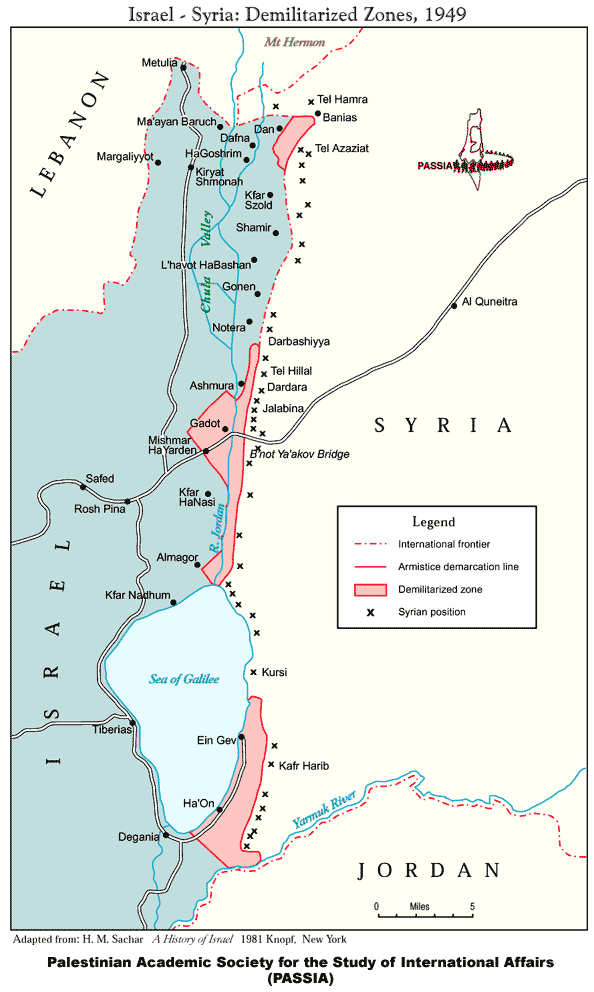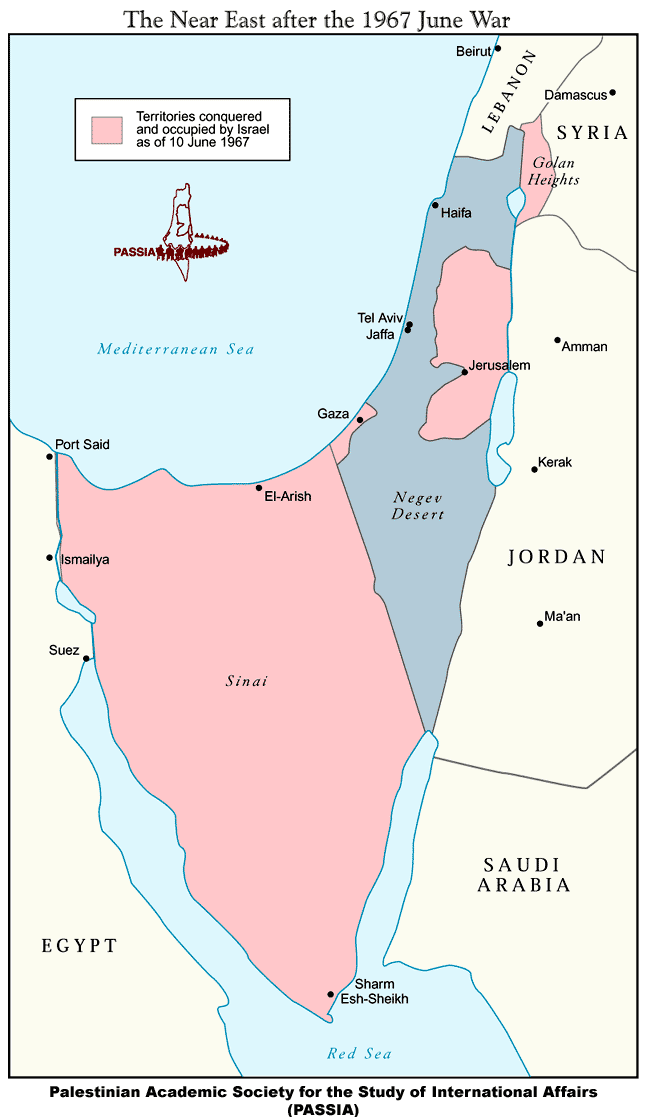How Did We Get Here?
A History of the Israel-Palestine Conflict
4. The 1967 War
This is the fourth of a series of eight lectures, sponsored by
A Jewish Voice for Peace.
This lecture was videotaped on Nov. 11, 2002. The lecturer is Joel
Beinin, professor of middle east history at Stanford University.
About Joel Beinin
Professor of Middle East history at Stanford University.
He is currently serving as the President of the Middle
East Studies Association of North America, and is also
involved with the Middle East Research and Information Project (MERIP)
and the Middle East Social and Cultural History Association.
His books include:
- Workers on the Nile: Nationalism, Communism, Islam and the
Egyptian Working Class, 1882-1954 (1987, Princeton University Press;
2000, American University in Cairo Press; co-authored with Zachary
Lockman)
- Intifada: The Palestinian Uprising Against Israeli Occupation
(1989, South End Press; co-edited with Zachary Lockman)
- Was the Red Flag Flying There? Marxist Politics and the Arab-Israeli
Conflict in Egypt and Israel, 1948-1965 (1990, University of California
Press)
- Political Islam: Essays from Middle East Report
(University of California Press, 1998; co-edited with Joe Stork)
- The Dispersion
of Egyptian Jewry: Culture, Politics, and the Formation of a Modern
Diaspora (1998, University of California Press).
- Workers and Peasants in the Modern Middle East
(Cambridge University Press, 2001)
Chronology
This is expanded from those events mentioned in the lecture, particularly
including events from the British Mandate period (1920-48). The events of
the 1947-49 war are representative but far from complete.
- 1948:
- May 14: Proclamation of the State of Israel.
- May 15-Jan. 7, 1949: First Arab-Israeli War.
- 1949:
- Feb. 24: Armistice with Egypt.
- Mar.: Israel completes occupation of Negev down to Eilat.
- Mar. 23: Armistice with Lebanon.
- Apr. 3: Armistice with Jordan.
- July 20: Armistice with Syria, with demilitarized zones around
'En Gev and Dardara.
- 1950:
- Apr. 4: Jordan annexes West Bank, including East Jerusalem.
- 1951:
- Feb. 12: Israel begins Huleh drainage work in DMZ with Syria.
- July 20: King Abdullah of Jordan assassinated.
- 1952:
- July 23: Free Officers' revolution in Egypt overthrows King Farouk.
- Aug. 11: Hussein proclaimed king of Jordan.
- 1953:
- Sept. 2: Israel starts work on Jordan River project; Syria
complains to UN Security Council.
- Oct. 15: Israeli reprisal attack on Qibia (Jordan), led by
Ariel Sharon, kills 53 Palestinians.
- Dec. 7: Moshe Sharett succeeds David Ben-Gurion as Prime Minister
of Israel.
- 1954:
- Apr. 17: Gamal Abdel Nasser becomes Prime Minister of Egypt.
- 1955:
- Nov. 2: David Ben-Gurion again becomes Prime Minister.
- Dec. 11: Operation Kinneret, under Ariel Sharon, kills 50
Syrians along the borders of the Sea of Galilee.
- 1956:
- July 26: Egypt nationalizes Suez Canal.
- Oct. 29-Nov. 7: Suez War.
- 1957:
- Mar. 10: Israel withdraws from Sinai and Gaza. UN Emergency
Force (UNEF) moves in.
- 1958:
- Feb. 1: Syria and Egypt merge to form United Arab Republic (UAR).
- July 14: Revolution in Iraq.
- 1959:
- Jan.: Fatah established by Yasser Arafat and associates.
- 1961:
- Sept. 28: Syrian coup leads to dissolution of UAR.
- 1962:
- 1963:
- Mar. 8: Ba'thist coup in Syria.
- June 16: David Ben-Gurion resigns as Israeli prime minister;
succeeded by Levi Eshkol.
- 1964:
- May 29: Palestine Liberation Organization (PLO) founded.
- June 5: Israel begins pumping water from Sea of Galilee into
its National Water Carrier.
- 1966:
- Feb. 23: Coup in Syria, followed by increased PLO activity against
Israel.
- Sept. 11:
- Nov. 9: Syria and Egypt sign mutual defense treaty.
- Nov. 13: Israeli "reprisal" raid against Samu, in West Bank
(Jordan).
- 1967:
- Apr. 7: Golan Heights exchange of fire, including tanks; Israel
shoots down seven Syrian MiGs, and flew victoriously over Damascus.
- May 12: Rabin threatens to overthrow Syria.
- May 13: Soviet Union tells Egypt that Israel is massing troops
to invade Syria.
- May 14: Syria requests that Egypt act to deter an Israeli
attack, invoking mutual defense treaty.
- May 15: Egypt deploy troops in Sinai.
- May 19: Egypt requests UNEF to leave border.
- May 22: Egypt closes Straits of Tiran to Israeli shipping.
- May 30: Egypt and Jordan sign mutual defense pact.
- June 2: Moshe Dayan joins Israeli Cabinet as Minister of Defense.
- June 5-10: Six Day War, initiated with Israel's pre-emptive attack
against Egypt's air force; ends with Israel in control of Sinai up to the
Suez Canal, Gaza, West Bank, and Golan Heights.
- June 27: Israel annexes East Jerusalem.
- Aug. 28-Sept. 2: Arab League summit at Khartoum.
- Nov. 22: UN Security Council Resolution 242.
- 1968: US delivers first Phantom jets to Israel.
- 1969:
- Mar. 11: Levi Eshkol dies; Golda Meir succeeds as Prime Minister.
- Mar.-Aug. 1970: Israeli-Egyptian War of Attrition.
- 1970:
- Aug. 7: Israeli-Egyptian cease-fire.
- Sept. 28: Nasser dies; succeeded by Anwar Sadat.
- 1971:
- Feb. 4: Sadat presents proposal for an interim settlement.
- 1973:
- Oct. 6-26: Yom Kippur War.
- Oct. 22: UN Security Council Resolution 338 calls for direct
negotiations.
- 1974:
- Jan. 18: Israeli-Egyptian disengagement agreement signed.
- Apr. 10: Golda Meir resigns; succeeded by Yitzhak Rabin.
- May 31: Israeli-Syrian disengagement agreement signed.
- 1977:
- May 17: Likud party takes control of Israel, with Menachem
Begin as Prime Minister.
- 1978:
- Sept. 17: Israel and Egypt sign Camp David Accords.
- 1981:
- Oct. 6: Sadat assassinated.
- Dec. 14: Israel annexes Golan Heights.
Glossary
- Ba'th (Baath): secular Arab socialist (anti-Marxist) political
movement, based originally in Syria from 1940; politically dominant
in Syria from 1963 and in Iraq from 1968.
- Fatah: founded in 1957 by Yasser Arafat as a paramilitary
organization fighting for the liberation of Palestine; joined PLO in
1969, which was subsequently led by Arafat.
- Herut: Revisionist Zionist political party, led by Menachem
Begin; forerunner of Likud.
- National Unity Government: formed shortly before 1967 war
by bringing opposition politicians, including Moshe Dayan and Menachem
Begin, into Levi Eshkol's Mapai-led government, lasting until 1970.
- Palestinian Liberation Organization (PLO): founded in 1964,
to provide a distinctly Palestinian political entity in opposition to
Israel (and Jordan); merged with Fatah in 1969, when Arafat took over.
- Rafi: Reshimat Poalei Israel (Israel Workers' List), political
party formed by David Ben-Gurion in 1965 when he split off more hawkish
elements (Moshe Dayan, Shimon Peres) from Mapai; in 1968 Rafi rejoined
Mapai and Ahdut Ha'avoda to form Labor party.
Historical Figures:
- Yasser Arafat (1929-): founded Fatah in 1956; joined PLO in
1968, and led PLO up to the 1993 Oslo Accords; elected President of the
Palestinian Authority, a post he still holds.
- Menachem Begin (1913-1992): leader of IZL (Irgun) militia
from 1943 until incorporated into IDF; led a series of right-wing
political parties (Herut, Gahal, Likud), briefly joining "unity"
government in 1967 just before the war; Prime Minister 1977-1982,
during which he signed the peace treaty with Egypt, and launched
Israel's invasion of Lebanon.
- David Ben-Gurion (1886-1973): first Prime Minister of Israel
(1948-53, again 1955-63), following his long leadership of the Histadrut
and Haganah during the Mandate period; in 1965 formed more hawkish Rafi
party in opposition to Mapai.
- Moshe Dayan (1915-1981): joined Haganah at age 14, rising to
IDF chief of staff from 1953-58; Minister of Agriculture from 1959-64,
but broke with Labor to join Ben-Gurion's opposition Rafi; became Minister
of Defense in National Unity Government in 1967, leading IDF through the
1967 War. Widely blamed for military failures in the 1973 Yom Kippur War,
leading to his resignation. Joined Begin's Likud government as Minister
of Foreign Affairs, and had a major role in negotiating peace treaty
with Egypt.
- Muhammad Fawzi (1915-2000): chief of staff of Egyptian army
during 1967 war.
- Levi Eshkol (1895-1969): Israeli Prime Minister from 1963-69.
- Hussein bin Talal (1935-99): King of Hashemite Kingdom of
Jordan from 1952 until his death.
- Golda Meir (1898-1978): Israeli Prime Minister from 1969-74.
- Gamal Abdel Nasser (1918-1970): Colonel in Egyptian Army
during Officers' Revolt, which overthrew King Farouk in 1952; President
of Egypt from 1954-70; nationalized Suez Canal in 1956, leading to 1956
Suez War; support for pan-Arabism briefly resulted in United Arab Republic
with Syria.
- Shimon Peres (1923-): close political ally of David Ben-Gurion,
was Director General of Defense Ministry from 1953-59, during which he
negotiated arms and nuclear technology deals with France; led Rafi party
from split with Mapai to merger with Labor Party; Prime Minister from
1986-88, 1995-96; Labor Party leader in National Unity governments with
Yitzhak Shamir and Ariel Sharon.
- Yitzhak Rabin (1922-1995): IDF chief of staff during 1967 War.
Later Ambassador to U.S., Prime Minister (1974-77, 1992-95).
- Anwar Sadat (1918-81): President of Egypt 1970-81. After his
peace initiatives in 1971 failed to progress, launched Yom Kippur War
in 1973, initially breaking through Israeli defense lines in Sinai,
leading to 1979 peace treaty with Israel, and his assassination in 1981.
- Ariel Sharon (1928-): Israeli military figure, notorious for
overkill -- starting with 1953 raid on Qibia. Head of IDF Northern Command
Staff from 1964, leading up to 1967 War. As Defense Minister from 1981,
launched Lebanon War, where he was found "indirectly responsible" for
1982 massacres of Palestinians at Sabra and Shatila refugee camps. Major
supporter of West Bank settlement programs, and opponent of Oslo Peace
Process, which he eventually subverted by catalyzing the second Intifada
and being elected Prime Minister in 2001.
- Moshe Sharett (1894-1965): Israeli Prime Minister 1954-55.
Suggested Readings
The website doesn't specify any recommended readings for this presentation,
but Joel Beinin mentions the following books:
- Benny Morris, Israel's Border Wars, 1949-1956: Arab Infiltration,
Israeli Retaliation, and the Countdown to the Suez War (1997, Oxford
University Press, paperback)
- Avi Shlaim, The Iron Wall: Israel and the Arab World (2001,
W.W. Norton, paperback)
- Michael B. Oren, The Six Day War: June 1967 and the Making of
the Modern Middle East (2003, Presidio Press, paperback)
The following are useful books that we are familiar with and recommend:
- Benny Morris, Righteous Victims: A History of the Zionist-Arab
Conflict, 1881-2001 (2001, Vintage Books, paperback)
- Norman G. Finkelstein, Image and Reality of the Israel-Palestine
Conflict (2nd edition, 2003, Verso, paperback)
Links
Maps
The map on the left shows the demilitarized zones (DMZ) between Israel
and Syria following their 1949 Armistice agreements. These zones were
the scene of numerous border clashes between Israel and Syria leading
up to the 1967 war. The water resources flowing into and out of the
Sea of Galilee (Lake Kinneret) were also a major source of conflict.
The map on the right shows the territories that Israel seized during
the 1967 War. One major goal of this war was for Israel to seize
the Egyptian town of Sharm Esh-Sheikh, which overlooked the Straits
of Tiran, a narrow passage from which Egypt could block shipping into
the Israeli port of Eilat (at the southern tip of Israel).

Israel-Syria Demilitarized Zones 1949
|

Near East After June 1967 War
|



